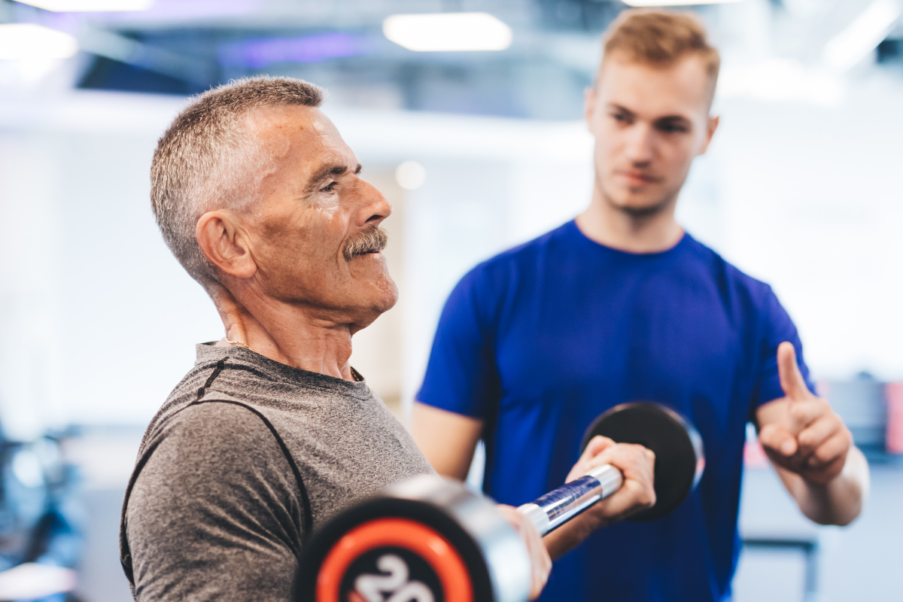Pilates Reformer: Standing Exercises
 Standing work on the reformer offers a perfect way to improve overall balance and posture and is a great complement to any other workout or Pilates routine. In this article, you will learn how to introduce the classic standing work—with a contemporary twist—to clients at any level, and you’ll learn how to progress or regress moves for those who need more or less.
Standing work on the reformer offers a perfect way to improve overall balance and posture and is a great complement to any other workout or Pilates routine. In this article, you will learn how to introduce the classic standing work—with a contemporary twist—to clients at any level, and you’ll learn how to progress or regress moves for those who need more or less.
Standing, walking and moving upright are essential everyday activities for the ambulatory population, so adding standing moves to a routine brings the work into the realm of functional fitness. By keeping us on our feet and moving, standing work helps preserve the body’s balancing system. In particular, exercises that force our musculature to bear weight and overcome resistance can support our joints and improve overall stability. Standing work engages the muscles of the feet and lower limbs and builds our core–and our fitness level–from the ground up, providing immediate feedback that we can apply in our daily lives.
Importance and Benefits of Standing Work
In many Pilates exercises, we focus on the muscles of our inner core: the transversus abdominis, the pelvic floor, the multifidi and the diaphragm. While these muscles play an important role in stabilizing the spine during small, controlled movements, they do not actually move the body as a whole.
Instead, we need to focus on using the muscles surrounding the hips and pelvis—our lumbopelvic area—and more specifically, in the standing work, the muscles of our lower limbs. Learning to engage these muscles as a powerhouse and as a dynamic center is the key to efficient, graceful and balanced movement. These systems work together to stabilize the pelvis and lumbar spine when they are under stress, as they are during lifting, bending, sitting, twisting, walking, running or jumping. Lumbopelvic stabilization is important because the bones of the spine are both mobile and delicate without the stability provided by the deep muscles that surround them.
The Neutral Pelvis
Maintaining neutral pelvis when doing standing work on the reformer is important because when the pelvis is in neutral, the action of gravity on the core musculature leads to balanced engagement of the muscles on the front and back of the spine. This decreases stress on the spine and helps prevent low-back pain and injury. To find neutral pelvis while standing, use the hips’ bony structures and your own hands. Bring your thumbs and index fingers into a triangle, placing the heels of your hands on the anterior superior iliac spine (ASIS) points on the front of your hips and placing the index fingers on your pubic bone. The goal is to have that triangle perpendicular to the floor.
Standing Exercises on the Reformer
The following exercises can be done on any standard reformer. Use the modifications and challenges provided to regress or progress the exercises according to your clients’ needs or your own. Keep in mind that when working on a reformer, less is usually more. What this means is that less weight means less stability, which means more work! Practice these exercises on their own, or incorporate some or all of them into a current routine for a wonderful addition to any fitness regimen.
Exercise 1: Side Split
Purpose. Strengthen adductors or abductors and improve standing balance and coordination.
Springs. One yellow to one blue for adductor focus; one red to two reds for abductor focus.
Start position. Facing one side of reformer, step up on stable side first and then onto carriage side. Keep feet in parallel position and pelvis neutral. Hands can start at hips to ensure pelvis stays steady and neutral.
Movement Sequence
Adductor focus. Inhale: Press carriage out. Exhale: Bring carriage back to stopper.
Abductor focus. Switch breathing above, and add more weight.
Progression
Saw. Start with arms to sides at shoulder height. As carriage moves out, hinge at hips and rotate torso toward carriage leg, keeping arms wide and straight.
Repeat any of the above 5–10 times on each side.
Photo credit: Photograph: Portia Page; Model: Lizbeth Garcia
For safety guidelines and more exercises, please see “Standing Work on the Reformer” in the online IDEA Library or in the May 2013 issue of IDEA Fitness Journal.
Portia Page
Portia Page is a faculty member of Balanced Body® as well as the Education Project Manager and a STOTT PILATES®-certified instructor. She has been in the fitness industry for over 20 years and has served as a teacher, competitor, program director, instructor trainer and international presenter. A gold-certified Pilates teacher through Pilates Method Alliance®, Portia has been a master instructor for 24-Hour Fitness® and has helped develop and cultivate several new programs for their instructors as well as conducted trainings throughout the United States and abroad. Certifications: ACE and AFAA





